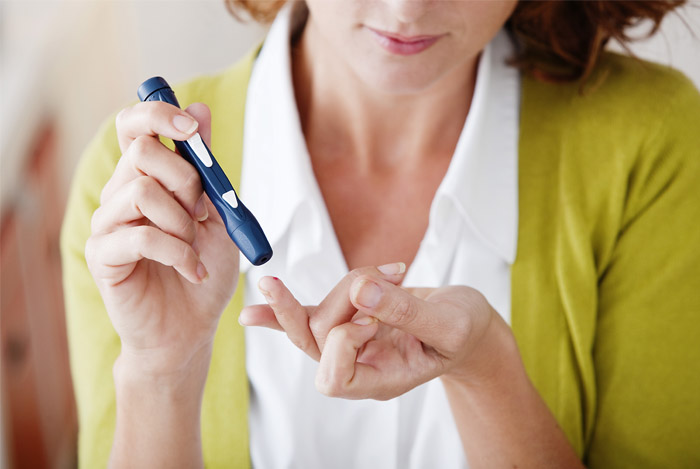One thing I always encounter with clients and people who read this site is a desire for healthy, diabetic friendly recipes and meal plans.
Even though I don’t have diabetes, I understand how frustrating it can be to constantly monitor everything you eat so you can balance your blood sugar. The risks associated with high blood sugar levels, like nerve damage, kidney disease, artery hardening, etc., are just too scary to ignore.
The good news is that there are diets out there that are perfect for managing diabetes the smart way, through a consistent approach to healthy eating and daily exercise, they offer delicious meals and effective tips to take the guesswork out of meal planning.
These diet tips will help you start enjoying food again.
But first, let’s make sure to establish an understanding about the different types of diabetes because we’re mainly talking about type 2 diabetes here.
The Difference Between Type 1 and Type 2 Diabetes

There are two types of diabetes, type 1 and type 2, but they have the same issue at their core: an inability to use glucose, or sugar, as fuel and energy for the body.
Type 1 diabetes used to be called childhood-onset diabetes because the condition manifested itself early on in life. When you have type 1 diabetes, your insulin supply levels aren’t big enough and you have to rely on insulin injections to regulate blood sugar. We need lots of the hormone insulin to help sugar get inside our cells and start working.
According to the Centers for Disease Control and Prevention (CDC), around 5-10% of diabetics have type 1 diabetes. Conversely, the majority of diabetes sufferers have type 2 diabetes, which was once only prevalent in adulthood. Sad to say it is now becoming more prevalent in adolescents and children too.
Most type 2 diabetics produce insulin just fine, but instead of the cells absorbing it, they become resistant to it. Since the insulin can’t work effectively to get the sugar inside the cells, the sugar has nowhere to go so it hangs out in the bloodstream. So type 2 diabetics have high blood sugar levels and need to work to regulate this back to normal.
The CDC believes that even though 21 million people have been diagnosed with diabetes, there’s an estimated 8 million undiagnosed cases. Have you had your blood sugar levels checked recently?
The Physicians Committee For Responsible Medicine states that: “Over the short run, people with uncontrolled diabetes may experience fatigue, thirst, frequent urination, and blurred vision. In the long run, they are at risk for heart disease, kidney problems, disorders of vision, nerve damage, and other difficulties”.
Wow, those are definitely not issues to mess around with. So how do we combat this? Well, there have been numerous studies aimed at changing the course of diabetes prevention and reversing it through diet.
In fact, Diabetes.co.UK says: “Effective management of diabetes cannot be achieved without an appropriate diet”.
Type 2 diabetes is entirely preventable and even reversible – in most cases. However, science has not figured out a direct cause or cure for type 1 diabetes. With proper dieting, type 1 diabetics may be still be able to reduce the amount of insulin they need to use, so that’s some good news.
Now that we know how critical the role of diet plays in the management of diabetes, what are the most delicious and effective diets for diabetes sufferers?
Best Diets for Diabetes

When it comes to diets for diabetes it can be a confusing issues. That’s because there is no one size fits all diabetes diet, but there are a couple of really important things to consider if you want to gain control of your diabetes and prevent complications.
- Focus on eating a whole foods diet
- Monitor carbohydrates
Focus on eating a whole foods diet
It goes without saying that a whole foods diet is the way to go for anyone, not just diabetics. It’s something I harp on about all the time here because processed foods, and junk are no good for any of us. These types of foods just happen to be more problematic for diabetics.
If you were to ask: “what is a whole foods diet?” I’d say it’s a diet that’s focused on the right kinds of fruits and vegetables, whole grains, proteins, and healthy fats.
But it does get slightly more complicated than that because then we have the whole carbohydrate thing to contend with.
Monitor carbohydrates
Carbohydrates have the single biggest influence over blood sugar so it’s the main macronutrient you need to focus on if you have diabetes.
Complex carbs are made from unprocessed sources and digest slower (think whole wheat bread, quinoa, and oats). Simple carbs, which are typically overly processed and commercially sweetened, cause quick, high spikes in blood sugar levels.
BUT…ALL carbohydrates will affect your blood sugar levels. While it’s important to choose healthy complex carbs, at the end of the day the amount of carbs counts too, which is why it’s important to stick to small portions of complex carbs.
And remember, carbs are hiding in more than just bread. So you need to be on your A-game to make sure you don’t eat too many.
Here’s a list of foods that contain carbs:
- Milk and yogurt
- Fruits and juices
- Rice, grains, cereals, and pasta
- Breads, tortillas, crackers, bagels, and rolls
- Dried beans, split peas, and lentils
- Potatoes, corn, yams, peas, and winter squash
- Desserts, honey, syrups, pastries, cookies, soda, and candy
When it comes to how many carbs to eat per day, it’s a highly debated issue. When you look around different sites the recommendations range from under 50 g per day up to 340 g per day.
That’s a big difference, and a lot of this will depend on your individual tolerance to carbs. So it’s important that you monitor and work out what works best for you.
3 Healthy Whole Foods Diets for Diabetes
The DASH Diet

The DASH diet wasn’t created specifically for diabetics, but was in fact created as a way to find Dietary Approaches to Stop Hypertension (DASH).
The US Department of Agriculture says that the DASH diet is one of the healthiest eating plans people should follow because it not only aims to prevent high blood pressure and diabetes, but if followed correctly, may cause people to gradually wean themselves off of their prescription medications.
The DASH diet places emphasis on consuming more whole grains, fruits, vegetables, nuts, and lean protein and dairy. You also cut out high sodium and high saturated fat.
One study published in Diabetes Care found that when type 2 diabetics started following the DASH diet, they reduced their levels of A1C, a measure of blood sugar over time, and even reduced their fasting blood sugar after eight weeks. The results also showed that HDL, the ‘good’, cholesterol was higher and LDL, the ‘bad’, cholesterol was lower.
A diet most people think the DASH diet was inspired by, the Mediterranean diet, is also a popular choice for diabetics.
The Mediterranean Diet
 The Mediterranean diet shares many similarities with the DASH diet; they both praise whole grains, fruits, vegetables, and nuts for their amazing dietary benefits and fiber, they both recommend eating lots of lean meat and fish, and they both allow low-fat dairy.
The Mediterranean diet shares many similarities with the DASH diet; they both praise whole grains, fruits, vegetables, and nuts for their amazing dietary benefits and fiber, they both recommend eating lots of lean meat and fish, and they both allow low-fat dairy.
Of course, the Mediterranean diet also allows for some red wine, bet you weren’t expecting that, right?
Well actually, a study of more than 220 type 2 diabetic patients showed that when people followed a Mediterranean diet and drank a 150 ml glass of red wine with their dinner for two years, they had significantly higher levels of HDL, or the good cholesterol. The participants who were able to metabolize the alcohol, quickly “tended to have better blood sugar control.”
I’ll drink to that finding! Just remember it’s just a small amount!
Another randomized control study compared a lower carb Mediterranean diet to a low fat diet and followed 215 newly diagnosed diabetics over 4 years. None of these people were taking medications at the beginning of the study.
After 4 years 44% of the Mediterranean group had to be given treatment compared to 70% in the low fat diet group. The people following the Mediterranean diet also lost more weight, had better blood sugar control, and better cardiovascular health as well.
If you’re interested in trying some Mediterranean meals, I shared five awesome meal plans in this post.
There’s also one other diet that’s had a fair amount of research to back it, the vegan diet.
The Vegan Diet
 By now we’re all familiar with the vegan diet: the diet that makes you forgo all animal products in favor of choosing plant-based options instead.
By now we’re all familiar with the vegan diet: the diet that makes you forgo all animal products in favor of choosing plant-based options instead.
The thinking here is that since animal-based products contain saturated fat and cholesterol, they should be avoided. Saturated fat and high cholesterol have been linked to cancer, heart disease, and even insulin resistance.
Plus, since animal products are extremely low carb, they offer zero fiber for our bodies, and they need fiber – especially if you’re suffering from diabetes.
Fiber does not raise blood glucose levels. The two kinds of fiber, insoluble and soluble, don’t get broken down by our bodies. Insoluble fiber helps our digestion function and soluble fiber helps lower cholesterol and improve blood glucose if eaten often enough. And if you’re following a vegan diet that’s naturally high in fiber, you’re all set!
While this may be the most extreme diet on the list, it may also bring with it some of the best benefits.
A study conducted by George Washington University and the University of Toronto examined the effects a low-fat, whole grain vegan diet on participants with type 2 diabetes over a 22 week trial period.
Some participants were given unlimited amounts of veggies, fruits, legumes, and whole grains in an attempt to follow a vegan meal plan. Other subjects followed a diet based on the American Diabetes Association (ADA) guidelines.
Here’s what the researchers discovered:
- 43% of the vegan group reduced their medications, compared to 26% on the ADA diet.
- Those whose medications did not change still had lower hemoglobin A1C, an index of long-term blood glucose control, by 1.2 points. This was three times higher than the change in the ADA group.
- The vegan group members lost an average of 13 pounds; the ADA participants only dropped 9 pounds
- Participants whose lipid-lowering medications remained the same still had more substantial decreases in their total and LDL cholesterol levels (the bad ones) compared to the ADA group.
One of the best things about being on a vegan diet is that you usually eat less than your recommended daily amount of calories since the fiber from all the fruits, veggies, and legumes fills you up and keeps you satisfied throughout the day – which leaves just a little bit of wiggle room in the dessert department.
What? Did you think I wouldn’t find a delicious diabetic-friendly vegan dessert?
This recipe for Chocolate Peanut Butter Cups will have you forgetting those terrible-for-you ones in the orange wrapper.
Bottom Layer:
- 2 tbsp coconut oil, melted
- 1/4 cup smooth peanut butter
- 1 tsp pure vanilla extract
- 1/4 cup unsweetened cocoa powder
- 2 packets pure stevia
Top Layer:
- 2 tbsp coconut oil, melted
- 1/4 cup natural smooth peanut butter
- 1/2 tsp pure vanilla extract
- 1 packet pure stevia
Directions:
- Line a mini muffin tray with 11 paper liners.
- Stir all ingredients for the bottom layer together until smooth and divide between the wells (each should be about half full). Put the tray in the freezer on a flat surface and freeze until solid (about 15 minutes).
- Meanwhile, stir all ingredients together for the top layer until smooth and divide on top of the set chocolate mixture. Return to the freezer and freeze until solid. Store the treats in the freezer.
Don’t Forget Exercise
Even though I tell everyone they need to pencil in time for exercise, I’m telling diabetics that they MUST exercise. No excuses, as studies prove exercise is mandatory for diabetics.
“Exercising muscles have a voracious appetite for fuel. When an individual is engaged in regular aerobic exercise, glucose is able to enter the cells without the need for as much – or perhaps any – insulin”. It improves your insulin sensitivity, lowers blood sugar levels, and just plain helps keep you healthier!
Final Thoughts
I hope these diabetic diet tips show you that living with diabetes doesn’t mean you have to suffer boring, bland meal plans or feel like you can’t eat what you want. No, you can’t have ice cream for dinner, but neither should non-diabetics!
These diet plans will not only help you live healthier, but they may actually help reverse your condition or reduce the amount of medication you need. Sounds like a win-win to me.
Have you tried any of the diets I’ve mentioned? I’d love to hear what works best for you in the comments.
The post 3 Delicious and Effective Diets for Diabetes Sufferers appeared first on Nutrition Secrets.
http://www.nutritionsecrets.com/diabetes-diet/
No comments:
Post a Comment